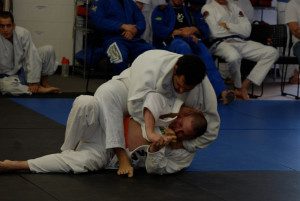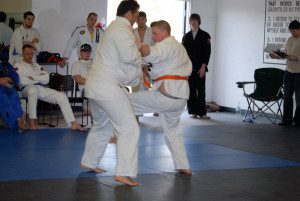By Jeff Patterson 8/12/09
The guard position in Brazilian Jiu Jitsu is defined by having your back on the ground and your legs between you and your opponent.
 There are many variations of the guard; two of the most common are the closed guard and the open guard. Having your opponent in your closed guard means your legs are locked around their body. In the open guard position your lock is broken and your legs are apart. The closed guard is considered the better defensive guard position (although there are many attacks you can implement from it) that greatly increases your control. In the open guard you can still play defense by using your feet, knees, shins, hands, forearms and elbows as a barrier. It is important while playing the open guard to stay ahead of your opponent by pushing and pulling with all of your limbs to disrupt his movement and break his base. Constantly moving your hips will give you the angles and the leverage to help keep you ahead of your opponent, giving you the advantage of being the initiator and making it easier to set up sweeps and go for submissions.
There are many variations of the guard; two of the most common are the closed guard and the open guard. Having your opponent in your closed guard means your legs are locked around their body. In the open guard position your lock is broken and your legs are apart. The closed guard is considered the better defensive guard position (although there are many attacks you can implement from it) that greatly increases your control. In the open guard you can still play defense by using your feet, knees, shins, hands, forearms and elbows as a barrier. It is important while playing the open guard to stay ahead of your opponent by pushing and pulling with all of your limbs to disrupt his movement and break his base. Constantly moving your hips will give you the angles and the leverage to help keep you ahead of your opponent, giving you the advantage of being the initiator and making it easier to set up sweeps and go for submissions.
If your opponent breaks this barrier and passes your legs to either a side control or mount you will find yourself in an extremely vulnerable position. Passing the guard is described in the international Brazilian Jiu Jitsu Federation rules section 4 under points: “Passing the guard- The athlete who is above is adversary and between his legs, moves to his opponents side and thereby establishes a perpendicular or longitudinal position over his adversary’s trunk-dominating him and leaving him no space to move or to escape the position, 3 points. Three points are rewarded regardless of whether the athlete underneath is on his side, back, or facing down.
Note: If the athlete underneath avoids the move by getting to his knees or standing up, the initiative will not be awarded the 3 points but will be awarded an advantage.” In a Jiu Jitsu competition your opponent will receive 3 points for passing your guard but in a MMA fight your opponent will gain the ability to put you in a vulnerable position for strikes. For this reason you will find a very scientific break down of the guard position. This is why practitioners of Brazilian Jiu-jitsu have dedicated so much time studying how to defend the guard.
The Brazilian Jiu-jitsu guard is not only a defensive position. Through studying the guard positions many sweeps, reversals and submissions have been developed. In Brazilian jiu jitsu the sweep or reversal will enable you to move from the bottom position to the top position. The International Brazilian Jiu Jitsu Federation describes the sweep in its rules, in Section 4 under points: “The sweep- the athlete underneath has the opponent in his guard (between his legs) or in half guard (having one of his adversary’s legs between his) and is able to get on top of his adversary by inverting his position, 2 points.” Sweeps occur when the bottom player uses his legs to gain the top position. One example is the scissor sweep. In the scissor sweep you will shrimp out, slide your shin across your opponents belt line as your other leg’s calf is on his knee or thigh. Then sit up to grab arm to take away his base while the other hand wraps the neck, under hooks the arm or wraps the body. Then as you fall back using your weight as momentum with a kicking motion scissor your feet to turn your opponent to his back.
Playing the Brazilian Jiu Jitsu guard game will give you the opportunity for the submission as well. A submission is any type of hold that forces your opponent to submit conveyed by tapping the body on the mat, verbally submitting, or losing consciousness- and end the fight. Submissions are described in the International Brazilian Jiu-jitsu federation rules section 1 as: “Submission- submission occurs when a technique forces an opponent into admitting defeat by: A. Tapping with the palm against his opponent or the floor in a visible manner. B. tapping with his feet on the ground (if he is unable to use his hands). C. Requesting verbally to the referee that the fight be stopped (if he can neither tap with his hands or his feet). D. Requesting the fight be ended if the athlete gets injured or feels physically incapable or unprepared”.
 Submissions are often divided in to two major groups, “chokes” and “joint locks”. Chokes: any grip or lock that constricts the blood flow to the brain or closing the wind pipe so he cannot breathe. A joint lock usually involves a technique that hyper extends or twists the opponents joint.
Submissions are often divided in to two major groups, “chokes” and “joint locks”. Chokes: any grip or lock that constricts the blood flow to the brain or closing the wind pipe so he cannot breathe. A joint lock usually involves a technique that hyper extends or twists the opponents joint.
This is a brief introduction to the Brazilian Jiu Jitsu guard and will hopefully give you some idea to the depth of training needed to be a good Jiu Jitsu player as well as a basic understanding of some common areas you will end up in when playing the guard. The Jiu-jitsu guard will help you defeat bigger and stronger opponents and is an important position to understand even if you do not like playing the guard. It will help you to understand how to avoid the position if you are good and understand the basics.
Contact us about Brazilian Jiu Jitsu
Learn more about Brazilian Jiu Jitsu Techniques and History



